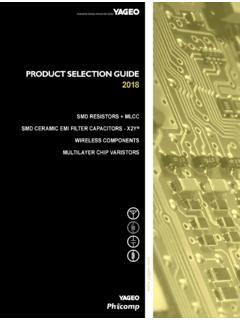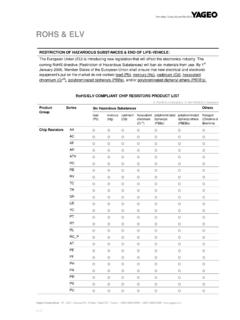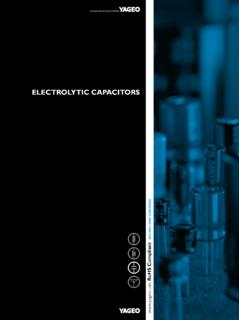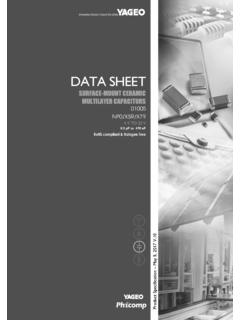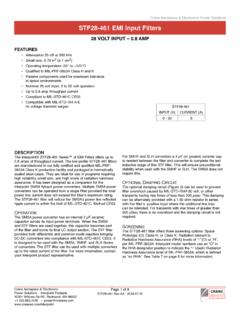Transcription of Current Sensing Chip Resistors - Yageo
1 SensingChip Resistors2 About YageoFounded in 1977, the Yageo Corporation has become a world-class provider of passive component services with capabilities on a global scale, including production and sales facilities in Asia, Europe and the Americas. Yageo currently ranks as the world in chip - Resistors , No. 3 in MLCCs and No. 4 in ferrite products, with a strong global presence: 21 sales offices in 15 countries, 9 production sites, 8 JIT logistic hubs, and 2 R&D centers worldwide. Ferroxcube and Vitrohm, who produce ferrites and leaded Resistors , are also a part of the Yageo support our customers with extensive literature including datasheets, brochures and application notes, which are also available electronically on our website at: of ContentsIntroduction.
2 3 Current - Sensing Circuit Applications ..4 Market Applications ..6 Product Portfolio ..7 Product Selection Tables ..103 Current Sensing chip ResistorsIntroductionIntroductionLow Resistance, High Power for Current Sensing ApplicationsCurrent measurement is very important in power and instrumentation systems for circuit control, protection, monitoring, and performance enhancement. Engineers in power supply and battery circuit designs need to consider a give-and-take strategy between low resistance values to minimize power losses and sufficient voltage supplies to avoid noises generated from the environments or particularly in switch mode power supplies.
3 Yageo s Current - Sensing chip Resistors are also fully compatible with today s high volume pick-and-place assembly systems. As such, they offer attractive, cost-effective solutions to designers of low voltage power supplies and battery management systems. Featuring a comprehensive resistance range of milli-ohms to 1 ohm (low-ohmic), and available from to 5 watts, they are not only applicable to battery packs, power supplies and converters, but also suitable for use in diverse power control circuits of tablets, notebook computers and hard now offers three types of surface-mount (SMT)
4 Current - Sensing chip Resistors based on thick film , metal foil, and metal plate technologies, with scalable product portfolios to meet the various demands of customers and their Features of Yageo s Current - Sensing chip Resistors Low resistance value from 1m to 20 m for minimizing power losses. High power-rating from to 5 watts. Tight tolerance within 2% to exhibit actual Current via voltage reading. Low TCR to avoid measurement distortions. TCR ranges from 50 to 100ppm/ C for metal and 100 to 1500ppm/ C for thick film Current sensors. Scalable off-the-shelf products in standard case sizes.
5 Compatibility with surface-mount assembly process. RoHS/REACH-compliant & low temperature coefficient of resistance (TCR) of Yageo 's Current - Sensing chip Resistors minimizes the resistance change caused by self-heating and high temperature environments. Thermal electromotive force (EMF) is also an important consideration. Thermal EMF is an important parameter of the metal foil series of battery management circuits, and of Current -sensor Resistors . Thermal electromotive force (EMF) of an Mn-Cu alloy is especially optimal with low EMF below uV/oC.
6 4 Low-Ohmic Resistors in Power-SensingCurrent-sensor Resistors are used in power Sensing applications such as Sensing output Current in power supplies and automotive engine management systems. As shown in Figure 1, a typical function for a Current -sensor chip resistor is as a Current -sensor (Rsense). This generates the Sensing voltage (Vs) for a feedback control network through which an output Current (Io) passes. The Sensing voltage triggers MOSFET switches, switching them ON and OFF to regulate the duty factor of the Current passing through a choke (L).
7 The Sensing voltage (Vs) is given by the simple relation:Vs = Io x RsenseThis Sensing voltage is generally set at around 100 mV both to save power and maintain satisfactory noise immunity. To sense a 5 A average output Current , Rsense must be 100 mV/5 A = 20 m . The power dissipation will then be:P = Io2 Rsense = 5 A x 5 A x 20 m = WA Current -sensor chip resistor with a power rating W would then be recommended for this application to provide an adequate safety margin. Over- Current DetectionAs a means to detect the Current passing through the transistor (see Figure 2), a resistor in series is added between an emitter and a ground.
8 This resistor shouldn't emit smoke or catch fire even when the switching transistor, subjected to a larger Current , breaks down. In addition, reduced parasitic inductance is required, particularly for high frequency switching control. Recommended Resistors with low resistance are metal-plate types, like the converterFigure 3 on the right shows the Current -detecting circuit of a DC/DC converter. The voltage across the Current -detecting resistor is fed back to control the output power. The resistance should be low to reduce power dissipation, and the resistor should withstand a repeated rush Current .
9 Furthermore, the self-inductance should be low for high-frequency applications. Recommended types are PE-series chip Resistors . As for high frequency DC/DC converters, metal-plate chip resistor , PE-series are the best 1 Current sensor chip resistor in Current Sensing applicationFigure 2 Over- Current protection circuitFigure 3 DC/DC converter circuitCurrent- Sensing Circuit Applications5 Current Sensing chip ResistorsIntroductionTight Tolerance in Sensing ResistanceThe magnitude of the output ripple depends on the inductance of the choke - the higher the inductance, the lower the ripple.
10 A high inductance choke, however, reduces the ability of the circuit to respond to high frequency transients. Such a choke will also be physically large, limiting the possibilities for miniaturization so essential to modern mobile equipment. A trade-off is therefore necessary between choke volume and output Current ripple. Experience indicates that a ripple of provides a good compromise in this area. With this ripple value, the peak output Current (Ipeak) is 2% greater than the average Current (Iavg): Ipeak = x Iavg (Figure 4).The voltage generated across the Sensing resistor is used in a feedback network to trigger the power-switching allow for variation in the characteristics of the power-switching IC, a safety margin for the Sensing -voltage is necessary.

